In its long history, Omega has contributed numerous important watches and innovations to the world of watchmaking. In this excerpt from our “Omega Milestones” E-Special, we chronicle seven of the 25 most important watches Omega has ever made. For the complete E-Special listing all 25, click here to download it from WatchTime’s online store.
1. First Minute-Repeater Wristwatch (1892)
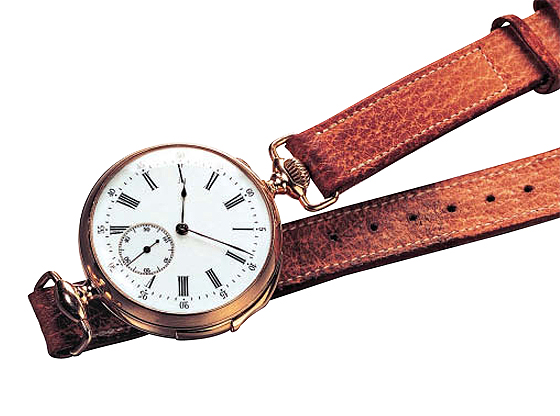
The world’s first minute-repeater wristwatch was unveiled in September 1892 by the Bienne, Switzerland firm of Louis Brandt & Frère, precursor to today’s Omega watch company. Brandt had chosen Audemars Piguet in Le Brassus to modify a 13-ligne Lépine ébauche that Audemars had purchased from the ébauche maker LeCoultre & Cie. The striking mechanism was triggered by a slide at 3 o’clock.
The complex wristwatch case strongly resembles that of a pocketwatch. Engraved on the dust cover is a phrase in French that translates as “Excluded from the competition: juror, Paris 1889.” The engraving suggests that the watch had been exhibited at the Chicago World’s Fair in 1893, but had not been allowed to participate in the competition for medals because César Brandt, who ran the firm with his brother Louis-Paul, had served on the jury of the Paris World’s Fair in 1889.
2. First Omega Wristwatch (1900)![Omega 1st Wristwatch]()
The first wristwatches bearing the Omega name were produced in 1900 and used by British officers in South Africa’s Boer War (1899-1903). Omega was one of the first firms to begin serial production of wristwatches. The watches withstood the rough treatment they got.
An Omega advertisement in a watchmakers’ magazine in Leipzig in 1904 publicized the testimony of a British artillery officer whose Omega wristwatch performed admirably in bitter cold, searing heat, torrential rain and merciless sandstorms. The lieutenant colonel concluded that “The wristwatch is an essential campaign element.” The wristwatches were powered by a Lépine 12-ligne Caliber HN B and were available in two versions: one with the crown on the right, to be worn on the left wrist, and the other with the crown on the left for wearing on the right wrist.
3. Omega Seamaster (1948)![Omega Seamasters, 1948]()
René Bannwart is considered the father of the Omega Seamaster line. The man who would later found Corum had begun building Omega’s design department in 1940. This was new. At that time, sketches for new models were usually drawn by draftsmen in watch-case factories. Bannwart’s decision set Omega on a new path that other brands would soon follow.
To celebrate Omega’s 100th anniversary, Omega sales director Adolphe Vallat asked Bannwart to develop a sporty, robust and waterproof wristwatch. Bannwart felt that Vallat wasn’t giving him enough time, so he presented one of his case designs with the comment “much too clunky.” To Bannwart’s surprise, Vallat was delighted. The result was the Seamaster family. It had its origins in watches supplied to Britain’s Royal Air Force in World War II.
The 1948 civilian version of the pilots’ watch had a water-resistant case (to 50 meters), a screwed caseback with lead gaskets, a reinforced crystal, a silvered dial, and polished and riveted Arabic numerals. The version with small seconds, which was also available as a certified chronometer, contained the new automatic Caliber 28.10 RA RG-343. The model with a central seconds hand was the 28.10 RA SC-350.
4. Omega Constellation (1952)![Omega Constellation, 1952]()
Omega began using the name “Constellation” in 1952 to denote its officially certified wrist chronometers. The premier model was powered by Caliber 28.10 RA SC PC RG AM (nicknamed the “352”), which first appeared in 1945. This caliber wound itself via a unidirectional hammer-type winding weight. It also featured an indirectly propelled central seconds hand. The 28.1-mm-diameter, 5.4-mm-thick movement passed the official chronometer tests with flying colors. Its sturdiness, reliability and precision prompted Omega to produce the Constellation in large numbers. This model was also Omega’s first serially manufactured wristwatch chronometer.
5. Omega Speedmaster (1957)![Omega Speedmaster, 1957]()
The Omega Speedmaster, destined to become the most famous chronograph in the world because of its use by NASA for the Apollo program, was introduced in 1957. But the Speedmaster story really begins in 1943 with chronograph Caliber 27 CHRO C12, developed by Jacques Reymond.
Born into a long-established family of watchmakers, Reymond had joined Omega’s subsidiary Lemania in 1942. The “CHRO” in the caliber designation stood for “chronograph,” the “27” referred to the movement’s diameter in millimeters, and “C12” denoted the additional counter for 12 elapsed hours. Further developed by Albert Piguet in 1946 and christened by Omega with the shorter name “321,” this movement was the smallest of its type at the time. Credit for the Speedmaster case design belonged to a group at Lemania, including designer Claude Baillod, prototype-maker Georges Hartmann and machinist Désiré Faivre. The watch’s salient features were a black dial, luminous hands, a tachymeter scale, water-resistant case, screwed back and domed Plexiglas crystal. The diameter was originally 39 mm. A 40-mm version with the tachymeter scale on a black background along the flange appeared in 1960.
6. Omega De Ville (1967)

Omega launched De Ville as a separate line in 1967. It had been a collection within the Seamaster line since 1960. Simpler, younger, more colorful, and more varied than the Seamaster, it quickly became Omega’s best-selling collection. The name stood for an entire philosophy because the De Ville wasn’t created at Omega’s headquarters in industrial Bienne, but in sophisticated Geneva.
The collection was intended to represent a new urban elegance. The designers had sought and found a modernistic element in wristwatch design. The collection included rectangular models containing the ultra-slim hand-wound Caliber 620. The synthesis of modernity and timelessness turned out to be just right. Omega De Ville wristwatches won six “Golden Roses” at the Baden-Baden design awards in the 1970s as well as the coveted Grand Prix Triomphe de l’Excellence Européenne.
7. First Co-Axial Escapement (1999)![Omega First Co-Axial Escapement]()
The Omega De Ville Co-Axial contained automatic Caliber 2500, the first wrist chronometer with a co-axial escapement. The escapement was invented by English master watchmaker George Daniels. Omega developed Daniels’s design so that it could be manufactured in large quantities. Caliber 2500 was a modified self-winding movement from Omega’s Swatch Group sister, ETA. The co-axial escapement went a long way toward solving two fundamental problems that had plagued long- lasting precision timekeeping.
First, every change in the viscosity of the lubricant oil detracted from the regularity of the rate behavior. Second, over time, the oil gradually disappeared from the locations where it was most needed in the movement. Daniels revised the architecture of the impulse-giving elements to reduce both the friction and the influence that the lubricant’s viscosity exerted on the balance’s amplitude.
Unlike conventional escapements, his co-axial escapement consists of an intervening wheel, a co-axial wheel and a lever with three pallet jewels. The lever acts only when the balance swings counter-clockwise. To fully exploit the advantages of this escapement, 27-jewel Caliber 2500 had a Glucydur balance with a frequency of 28,800 vph and a flat, freely swinging hairspring. The movement debuted in a simple round case for which Omega reactivated the name “De Ville.”
For the complete 25 “Omega Watch Milestones” including the first wristwatch tourbillon, the Olympic Timer from 1932, the RAF Broad Arrow, the Seamaster Ploprof, and the first Omega Liquidmetal watch, download the E-Special now from the WatchTime online store.
This article was originally published in 2015 and has been updated.

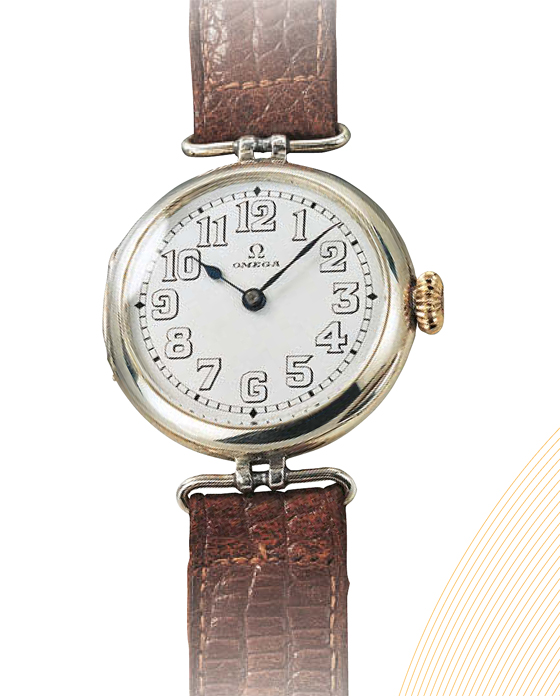

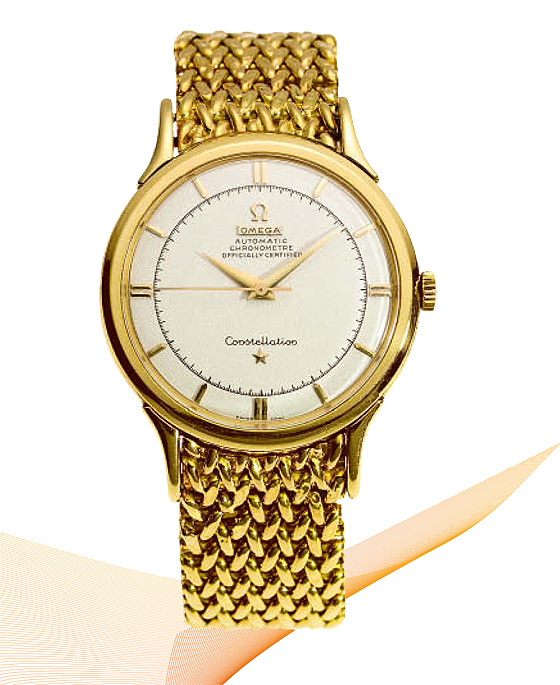
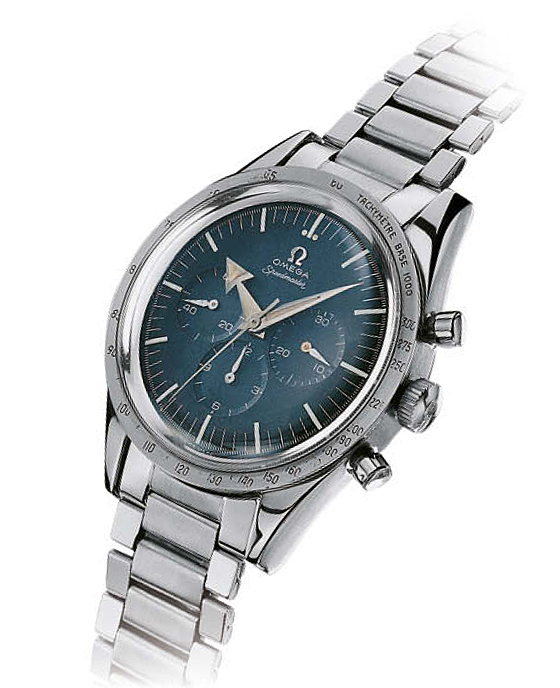
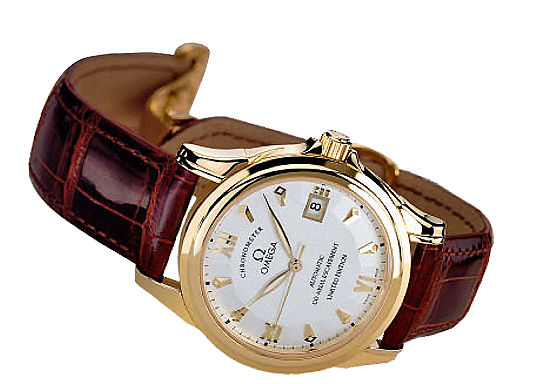

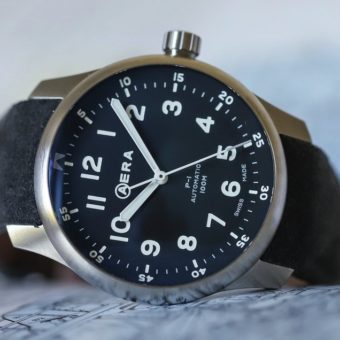
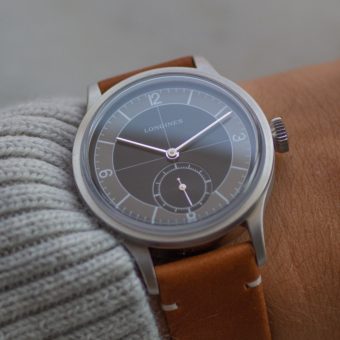

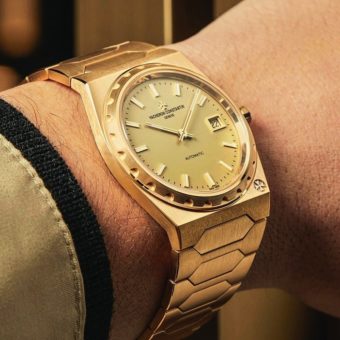
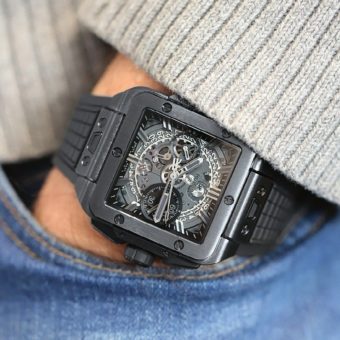
I have an omega that I traced to 1851 the casing was made by Dennison 18ct gold in perfect working condition I believe is the oldest complete omega it has a B and anchor we believe it was comissioned by the Queen for Admirals of the Royal British navy
Need a little help here on a (I think 1945 to 47 omega
Movement # 11925212 and case # F6516 and W162428.. and thanks so much watch is gold and beat up bad . If worth it I may restore it .. thanks again, Thomas
I have a very lightly used Seamaster with an 1109 cal, as I understand. I bought it second hand. On my initial opening of the back I found a round plate in place, looked a bit like a Mexican sombrero. Having never seen one I discovered it is a dust over. My problem is I have no idea how to remove it. I have searched and found pictures of sombrero like dust covers, but no guidance on how to remove it. The watch is beautiful, and I don’t want to harm it. It is probably very simple, but I have no idea, believing safe is the way to go. Ask the experts how to remove a dust cover in order to inspect the movement. Can you folks point neon the right direction? I will be sincerely appreciated!
Hi Gisbert,
I have an Omega watch; I think is at least 90 years old. The dial has only the name Omega and Swiss on the 6 hour location. Does not say model or anything else.
Please advise where can get vintage and more information for the watch.
Regards
Surender Chibber
I started my collection with a Seiko Diver, progressing to a Tag and ended up with a Seamaster PO. My grail watch.
GREAT STYLES
I had my first omega when I was 18 years old and still have it now.I am 77 years old and l collect omega watches 1950 watches are the ones Iove because of simple look of the watches.
And what makes the Calibre 8500 even more a historical Omega icon is that it was the first watch which is recorded to resist more than 15,000 Gauss magnetic resistance.
I definitely think that the tourbillon wristwatch calibers should be included in this… first of their kind in (limited) production.
It has to be 8 milestones: Omega called the Co-Axial movement a turning point for Omega and calibre 8500 the cornerstone of a new series of calibres. This specific calibre is the rehabilitation of a long lasting tradition of in-house manufacturing and emotional calibre 8500 can been seen as the rebirth of Omega. All together the calibre 8500 is a revolutionary horological milestone and a real historical Omega icon.
I have a James Bond Seamaster from the early 2000s. It has been through hell and back (even surviving a serious bike accident that I almost didn’t) and it still runs flawlessly, even despite having never been serviced. I tell all collectors that no watch collection is complete without an Omega of some sort.
The watch advert from 1904 is incorrectly described.
The watch was a wristlet pocket watch holder, nothing like the one depicted, and the officer was a Canadian by the name of Hurdman. The watch movements used were the 6, 6B, 6CC, or the smaller ladies size 0, 0B or 0CC.
I have a copy of the advert.
Acrowot: you must be some grudge holding person to tell the same story twice. I have 4 Omega watches and they are all one could expect.
I had a Constellation in 1955 and was the worst watch I ever had. It went back to Omega, but was never any good! Will never buy an Omega again!
Purchased a gold Constellation at a military BX in 1962. Best watch I’ve ever owned. Still have it as my daily wearer. Keeps much better time than than the Rolex it replaced. Have had it serviced once at the 20 year point.
I bought a Constellation certifed chronometer in 1955. It went back to Omega several times and was the worst watch I ever had! Would never think of buying another Omega after that! The box was better than the watch and eventually I as good as gave the watch away.
There are so very many better-looking examples of the Constellation – how could you choose that one? I’m afraid someone new to the model will see that monstrosity and forever swear off collecting that model. Why not a 1950s pie pan?
yes..the best one from the 50’s is the piepan